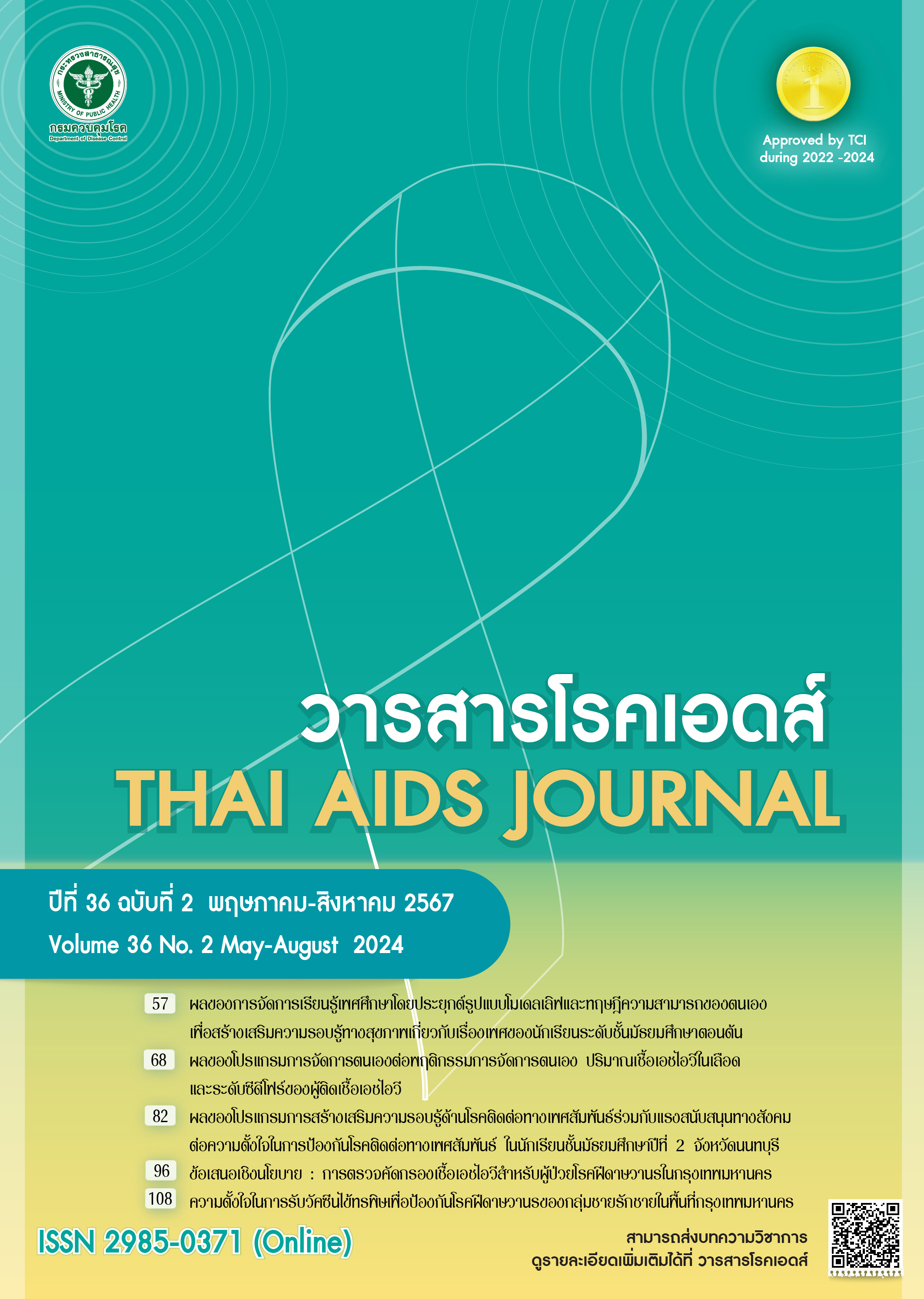ผลของโปรแกรมการสร้างเสริมความรอบรู้ด้านโรคติดต่อทางเพศสัมพันธ์ร่วมกับแรงสนับสนุนทางสังคมต่อความตั้งใจในการป้องกันโรคติดต่อทางเพศสัมพันธ์ ในนักเรียนชั้นมัธยมศึกษาปีที่ 2 จังหวัดนนทบุรี
DOI:
https://doi.org/10.14456/taj.2024.8คำสำคัญ:
ความตั้งใจในการป้องกันโรคติดต่อทางเพศสัมพันธ์, ความรอบรู้ด้านโรคติดต่อทางเพศสัมพันธ์, แรงสนับสนุนทางสังคมจากเพื่อนบทคัดย่อ
การวิจัยกึ่งทดลองนี้ มีวัตถุประสงค์เพื่อศึกษาผลของโปรแกรมสุขศึกษาต่อความรอบรู้ด้านโรคติดต่อทางเพศสัมพันธ์ และความตั้งใจในการป้องกันโรคติดต่อทางเพศสัมพันธ์ในนักเรียนชั้นมัธยมศึกษาปีที่ 2 จังหวัดนนทบุรี กลุ่มตัวอย่างทั้งหมด 71 คน เป็นกลุ่มทดลอง 32 คน และกลุ่มเปรียบเทียบ 39 คน กลุ่มทดลองได้รับโปรแกรม สุขศึกษาที่พัฒนาขึ้นจากการประยุกต์ใช้แนวคิดความรอบรู้ด้านสุขภาพร่วมกับแรงสนับสนุนทางสังคม จัดกิจกรรมตามโปรแกรมทั้งหมด 7 ครั้ง ครั้งละ 50 นาที ระยะเวลา 6 สัปดาห์ กิจกรรมคือ การฝึกทักษะเข้าถึง เข้าใจ ไต่ถาม ตัดสินใจ และนำไปใช้ ด้วยการบรรยาย เรียนรู้จากคลิปวิดีโอ เข้าร่วมฐานกิจกรรม ระดมสมอง นำเสนอและอภิปรายกลุ่ม และการให้แรงสนับสนุนทางสังคมจากเพื่อน เก็บรวบรวมข้อมูลด้วยแบบสอบถามก่อนและหลังการทดลอง การวิเคราะห์ข้อมูลใช้สถิติเชิงพรรณนา ได้แก่ การแจกแจงความถี่ ค่าเฉลี่ย ส่วนเบี่ยงเบนมาตรฐาน ค่าต่ำสุด และสูงสุด และสถิติเชิงวิเคราะห์ ได้แก่ Chi-square, Paired t-test, Independent t-test, Wilcoxon Signed Ranks test และ Mann-Whitney U test พบว่า ภายหลังการทดลอง กลุ่มทดลองมีทักษะการเข้าถึง เข้าใจ ไต่ถาม ตัดสินใจ นำไปใช้ ความรอบรู้ด้านโรคติดต่อทางเพศสัมพันธ์ในภาพรวม และความตั้งใจในการป้องกันโรคติดต่อ ทางเพศสัมพันธ์สูงกว่าก่อนการทดลองและกลุ่มเปรียบเทียบอย่างมีนัยสำคัญทางสถิติ (p<0.05) ดังนั้น กระทรวงศึกษาธิการควรมีนโยบายให้โรงเรียน ครู และผู้ที่เกี่ยวข้องบูรณาการเนื้อหาและวิธีการจัดการเรียนการสอนและจัดให้มีกิจกรรมเสริมทักษะอย่างต่อเนื่อง เพื่อเพิ่มทักษะความรอบรู้ด้านโรคติดต่อทางเพศสัมพันธ์ รวมถึงเพิ่มบทบาทของเพื่อน ผู้ปกครอง และคุณครูในการส่งเสริมให้นักเรียนมีพฤติกรรมป้องกันโรคติดต่อทางเพศสัมพันธ์ อย่างเหมาะสม
Downloads
เอกสารอ้างอิง
Division of AIDS and STIs. The rates of infection for the top 5 sexually transmitted infections (STIs) [Internet]. Nonthaburi: Division of AIDS and STIs; 2019 [cited 2022 Aug 20]. Available from: https://hivhub.ddc.moph.go.th/epidemic.php (in Thai)
Centers for Disease Control and Prevention (CDC). Sexually transmitted diseases, adolescents and young adults [Internet]. Georgia: Centers for Disease Control and Prevention; 2021 [cited 2022 Aug 20]. Available from: https://www.cdc.gov/std/life-stages-populations/adolescents-youngadults.htm
Division of Epidemiology. Situation of 5 sexually transmitted infections: AIDS Surveillance System [Internet]. Nonthaburi: Division of Epidemiology; 2023 [cited 2023 Aug 20]. Available from: http://aidsboe.moph.go.th/aids_system/ (in Thai)
Division of Epidemiology. Behavioral sentinel surveillance: AIDS surveillance system [Internet]. Nonthaburi: Division of Epidemiology; 2019 [cited 2022 Aug 25]. Available from: http://aids boe.moph.go.th/aids_system/ (in Thai)
Therawiwat M, Imamee N, Worraka A. Factors affecting sexual risk behaviors among female adolescents: a case study of female junior high school students, Kanchanaburi Province. Journal of Public Health. 2017;46(3):284-98. (in Thai)
Tipwareerom W, Jalayondeja C, Hanrungcharotorn U. Predicting factors of condom use among high school boys. Journal of Health and Nursing Research. 2020;36(3):69-7. (in Thai)
Boonrod T. Sexual risk behaviors and associated factors related to sexual activity among adolescents in schools under the jurisdiction of the Office of the Committee for Vocational Education, Muang District, in a province in the southern region [Master of Public Health]. Khon Kaen: Khon Kaen University; 2007. 90 p. (in Thai)
Vamos CA, Puccio JA, Griner SB, Logan RG, Piepenbrink R, Cayama MR, et al. Health literacy needs and preferences for a technology-based intervention to improve college students' sexual and reproductive health. J Am Coll Health. 2017;72(2):477-86.
Majumdar D. Social support and risky sexual behavior among adolescents: The protective role of parents and best friends. Journal of Applied Social Science. 2006;23(1):28-43.
United Nations Economic and Social Council. Implementing the internationally agreed goals and commitments in regard to global public health. New York: United Nations Economic and Social Council; 2009.
World Health Organization. Health literacy [Internet]. Geneva: World Health Organization; 2023 [cited 2023 Dec 10]. Available from: https://www.who.int/teams/health-promotion/enhanced-wellbeing/ninth-global-conference/health-literacy
DeWalt DA, Berkman ND, Sheridan S, Lohr KN, Pignone MP. Literacy and health outcomes: a systematic review of the literature. J Gen Intern Med. 2004;19(12):1228-39.
Padpai I, Saencham P, Chotchaisri T, Chantasuk S, Meelun N, Sripromsa W. The relationship between sexual health knowledge and hiv/aids and sexually transmitted infections prevention behaviors in adolescents in Northeastern Thailand. Nurse Colleges Public Health. 2022;9(1):296-309. (in Thai)
Prayochmee V, The effects of health literacy program on sexual prevention behaviors among junior high school students [Doctor of Nursing Practice]. Samut Prakan: Huachiew Chalermprakiet University; 2019. 166 p. (in Thai)
Kaeodumkoeng K. Health literacy process practice evaluation tools. Bangkok: ID All Digital Print; 2021. (in Thai)
Division of AIDS and STIs. Handbook for enhancing on HIV & STIs literacy. Nonthaburi: Division of AIDS and STIs; 2020. (in Thai)
House JS. Work stress and social support. Reading, MA: Addison-Wesley; 1981.
Chaiyachat P, Saranrittichai K. The effects of health literacy and social support development program on pregnant prevention behaviors for early adolescent. Journal of Nursing and Therapeutic Care. 2019;37(4):42-51. (in Thai)
Fleiss JL. Statistical methods for rates and proportions. London: John Wiley & Sons; 1981.
Sorensen K, Van den Broucke S, Pelikan JM, Fullam J, Doyle G, Slonska Z, et al. Measuring health literacy in populations: illuminating the design and development process of the European health literacy survey questionnaire (HLS-EU-Q). BMC Public Health. 2013;13:948.
Kaeodumkoeng K, Junhasobhaga J. A development and testing of health literacy on disease prevention and control assessment form for public health officers. Romphruek Journal of the Humanities and Social Sciences. 2021;39(2):193-220. (in Thai)
Likert R. A technique for the measurement of attitudes. Arch Psychol. 1932;140:1-55.
Bloom BS. Handbook on formative and summative evaluation of student learning. New York: McGraw-Hill; 1971.
Seechalee P, Duangsong R. The effects of pregnancy prevention program by application of health literacy concept among secondary school female students in Udon Thani Province. KKU Journal for Public Health Research. 2022;15(1):24-36. (in Thai)
Soofon P. The result of HIV literacy program to promote behavior of living together without abhorrence among village health volunteers. Thai AIDS Journal. 2020;32(1):1-4.
Bualeoy W, Thirawiwat M, Watthanasomboon P, Imami N. Effectiveness of a sex education program to prevent sexual risk behaviors on grade 8 students, Sampran District, Nakhon Pathom Province. Rama Nurs J. 2014;42(1):127-42. (in Thai)
Piyayothai S, Kaewdamkerng N, Makakun J, Chaicharoen S, Jaingam B, Khienwari K. Development of a skill training activity model to enhance knowledge on HIV and STIs to promote condom use among adolescents and youth. Thai AIDS Journal. 2021;33(3):111-22. (in Thai)
Nutbeam D. Health literacy as a public health goal: a challenge for contemporary health education and communication strategies into the 21st century. Health Promote Int. 2000;15(3):259-67.
Pratchayakhup P, Luangubol J, Promasatayapro V. The development of health literacy model for HIV and sexual transmitted infectionsamong adolescents, Yasothon Province. Academic Journal of Community Public Health. 2023;9(2):30-9. (in Thai)



